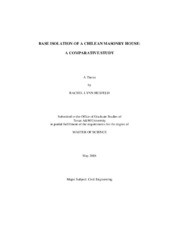| dc.description.abstract | The objective of this study is to reduce the interstory drifts, floor accelerations,
and shear forces experienced by masonry houses subject to seismic excitation. Ambient
vibration testing was performed on a case study structure in Maip�, Chile, to identify
characteristics of the system. Upon creating a multiple degree-of-freedom (MDOF)
model of the structure, the effect of implementing several base isolation techniques is
assessed. The isolation techniques analyzed include the use of friction pendulum
systems (FPS), high-damping rubber bearings (HDRB), two hybrid systems involving
HDRB and shape memory alloys (SMA), and precast-prestressed pile (PPP) isolators.
The dynamic behavior of each device is numerically modeled using analytical
formulations and experimental data through the means of fuzzy inference systems (FIS)
and S-functions. A multiobjective genetic algorithm is utilized to optimize the
parameters of the FPS and the PPP isolation systems, while a trial-and-error method is
employed to optimize characteristic parameters of the other devices.
Two cases are studied: one case involves using eight devices in each isolation
system and optimizing the parameters of each device, resulting in different isolated
periods for each system, while the other case involves using the number of devices and
device parameters that result in a 1.0 sec fundamental period of vibration for each baseisolated
structure. For both cases, the optimized devices are simulated in the numerical
model of the case study structure, which is subjected to a suite of earthquake records.
Numerical results for the devices studied indicate significant reductions in
responses of the base-isolated structures in comparison with their counterparts in the
fixed-base structure. Metrics monitored include base shear, structural shear, interstory drift, and floor acceleration. In particular, the PPP isolation system in the first case
reduces the peak base shear, RMS floor acceleration, peak structural shear, peak
interstory drift, and peak floor acceleration by at least 88, 87, 95, 95, and 94%,
respectively, for all of the Chilean earthquakes considered. The PPP isolation system in
the second case (yielding a 1.0 sec period) and the FPS isolation systems in both cases
also significantly reduce the response of the base-isolated structure from that of the
fixed-base structure. | en |


